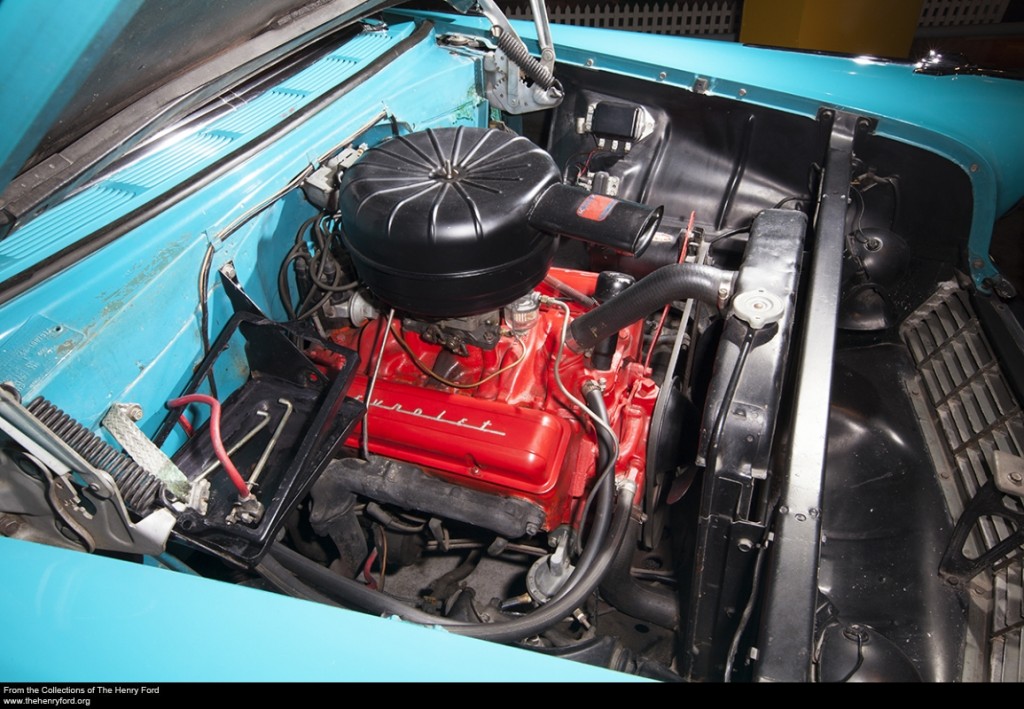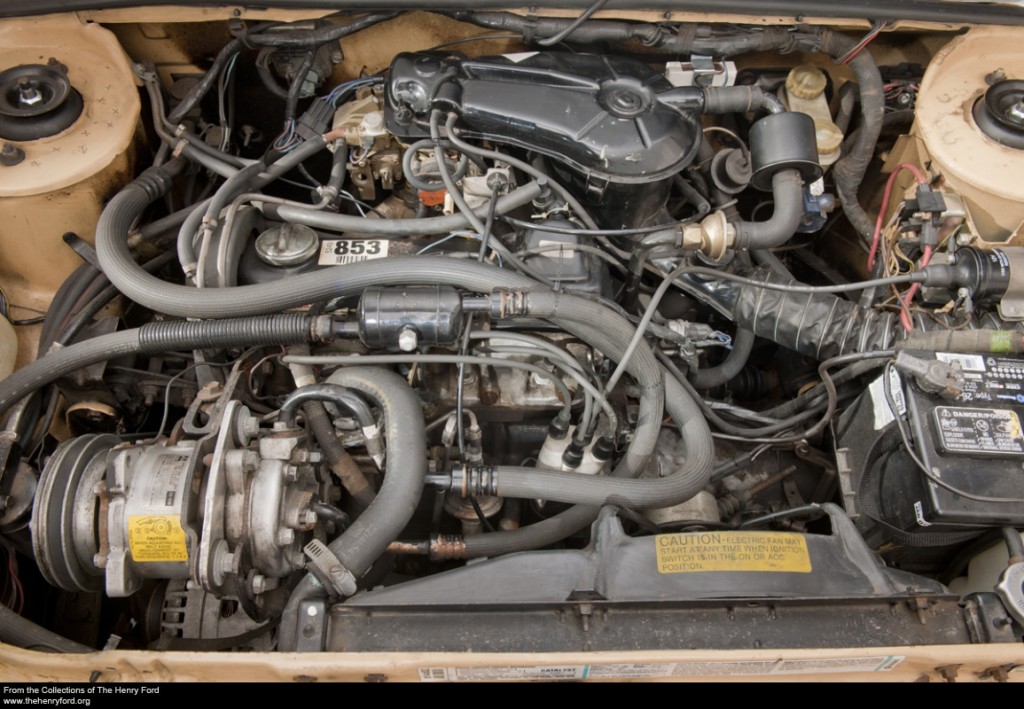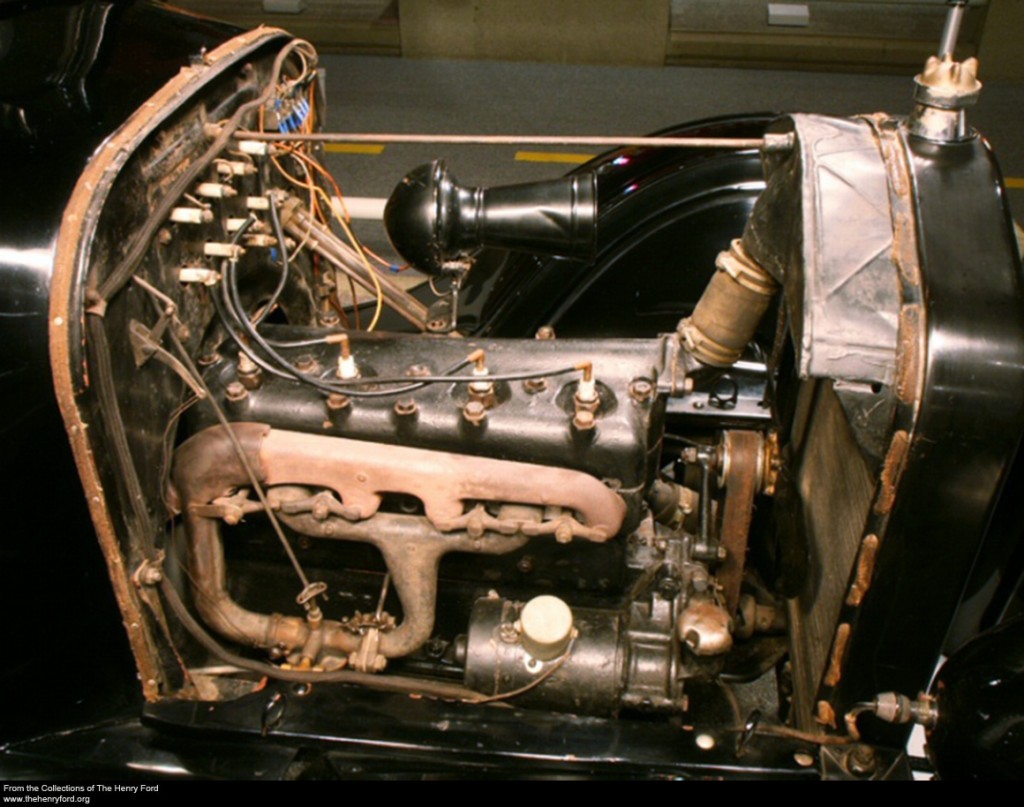Posts Tagged engines
Engines Exposed: 1963 Chrysler Turbine

When we look at an automobile, we are moved by what we see on the outside – its styling. But what moves the car is on the inside – its engine. Please join us for a rare look under the hoods of some of the finest automobiles at Henry Ford Museum. More than 40 cars have their engines exposed for you.
Here, Matt Anderson, Curator of Transportation at The Henry Ford, describes some of his favorites.

Engines Exposed: 1963 Chrysler Turbine
Regenerative gas turbine engine, 130 horsepower
Chrysler’s experimental turbine engine had 80 percent fewer moving parts than a piston engine, producing a very smooth ride. Regenerative turbines used gasses twice – once to drive the car and again to heat new air drawn into the system. Fuel flexibility was terrific (it ran on anything from gasoline to peanut oil) but fuel mileage (around 11.5 m.p.g.) wasn’t so hot.
1960s, 20th century, Henry Ford Museum, Engines Exposed, engines, Driving America, cars, by Matt Anderson
Engines Exposed: 1968 Mercury Cougar

When we look at an automobile, we are moved by what we see on the outside – its styling. But what moves the car is on the inside – its engine. Please join us for a rare look under the hoods of some of the finest automobiles at Henry Ford Museum. More than 40 cars have their engines exposed for you.
Here, Matt Anderson, Curator of Transportation at The Henry Ford, describes some of his favorites.

Engines Exposed: 1968 Mercury Cougar
V-8 cylinder engine, overhead valves, 390 cubic inches displacement, 335 horsepower
Unlike other pony cars, the upscale Cougar didn’t bother with 6-bangers. V-8 was the only available engine layout. This XR7-G model is equipped with Mercury’s 390-4V engine. The “V” is for Venturi, meaning that there’s a four-barrel carburetor under that air cleaner. And the “G” in the model name? That’s for Dan Gurney, who raced Cougars in Trans Am competition.
20th century, 1960s, Henry Ford Museum, Engines Exposed, engines, Driving America, cars, by Matt Anderson
Engines Exposed: 1960 Chevrolet Corvair

When we look at an automobile, we are moved by what we see on the outside – its styling. But what moves the car is on the inside – its engine. Please join us for a rare look under the hoods of some of the finest automobiles at Henry Ford Museum. More than 40 cars have their engines exposed for you.
Here, Matt Anderson, Curator of Transportation at The Henry Ford, describes some of his favorites.

Engines Exposed: 1960 Chevrolet Corvair
Horizontally opposed 6-cylinder engine, overhead valves, 140 cubic inches displacement, 80 horsepower
Chevrolet took the engine to a place it had rarely been in an American production car – the rear. Much of the motor is hidden by a metal shroud directing air flow from the deck louvers. There are two carburetors, one for each cylinder bank, connected to a single air cleaner at center. Later models increased trunk size up front by moving the spare tire to the engine compartment.
20th century, 1960s, Henry Ford Museum, events, Engines Exposed, engines, Driving America, Chevrolet, cars, by Matt Anderson
Engines Exposed: 1896 Ford Quadricycle

When we look at an automobile, we are moved by what we see on the outside – its styling. But what moves the car is on the inside – its engine. Please join us for a rare look under the hoods of some of the finest automobiles at Henry Ford Museum. More than 40 cars have their engines exposed for you.
Here, Matt Anderson, Curator of Transportation at The Henry Ford, describes some of his favorites.

Engines Exposed: 1896 Ford Quadricycle
Inline 2-cylinder engine, F-head valves, 59 cubic inches displacement, 4 horsepower (estimate)
Henry Ford based the Quadricycle’s engine on the Kane-Pennington motor he saw in American Machinist magazine. Ford brazed water jackets around each of the two horizontal cylinders and mounted wooden water tanks on either side of his engine. The tanks ultimately were replaced with a smaller under-seat reservoir.
Driving America, cars, Henry Ford, Henry Ford Museum, Engines Exposed, quadricycle, engines
Steam-Powered Agriculture
Before the Age of Steam, American farmers hand-threshed wheat or oats with a flail. Threshing machines powered by horses or portable steam engines increased daily production of threshing by a hundred times.
In the 1800s, the large number of horses required for farming consumed a lot of grain. Starting in the 1860s, farmers began threshing grain to feed those horses with a cousin of the "iron horse" - a steam traction engine like the Port Huron Thresher shown above.
As a Michigan farm boy, Henry Ford recorded his first sight of a traction engine: "I remember that engine as though I had seen it only yesterday, for it was the first vehicle other than horse drawn that I had ever seen. It was intended to drive threshing machines and power sawmills and was simply a portable engine and a boiler mounted on wheels." The steam traction engine inspired Ford to design and manufacture automobiles. To other rural people it represented a grand transition in American agriculture, and a new community activity. Continue Reading
farming equipment, power, Greenfield Village, engines, agriculture
Engines Exposed: 1963 Chrysler Turbine
Regenerative gas turbine engine, 130 horsepower.
Chrysler experimented with turbine engines for some 25 years. The Turbine could run on almost anything – gasoline, diesel, kerosene, even peanut oil (with exhaust that smelled like baking cookies)! While the fuel flexibility was terrific, the fuel economy was less than stellar. Chrysler ended the Turbine program in 1979. Note the huge air filter housing in front of the engine. The Turbine gulped about four times more air than a piston engine.
Matt Anderson is Curator of Transportation at The Henry Ford.
1960s, 20th century, Henry Ford Museum, Engines Exposed, engines, Driving America, cars, by Matt Anderson
Engines Exposed: 1956 Chevrolet Bel Air
V-8 cylinder engine, overhead valves, 265 cubic inches displacement, 205 horsepower.
It’s the most enduring 8-cylinder American automobile engine. Chevrolet introduced its “small block” V-8 in 1955 – and kept on building it until 2003. Nearly every General Motors division used some variant, and total production is over 100 million, including later development generations. Not bad for an engine designed in 15 weeks. The compact unit is all but swallowed up by the Chevy’s engine bay. Note the relatively small-sized radiator, too. Efficient cooling was one of the small block’s many advantages.
Matt Anderson is Curator of Transportation at The Henry Ford.
20th century, 1950s, Henry Ford Museum, Engines Exposed, engines, Driving America, convertibles, Chevrolet, cars, by Matt Anderson
Engines Exposed: 1978 Dodge Omni
Inline 4-cylinder engine, overhead valves, 105 cubic inches displacement, 75 horsepower.
Small cars pack a lot into tight spaces. The Omni makes the most of its engine bay by mounting the unit transversely, with the crankshaft parallel to the front bumper. It’s a layout not widely used in American cars since the early 1900s, but particularly well-suited to compact front-wheel drive vehicles. Power is sent to the Omni’s front wheels via the transaxle, a combination gearbox-differential, on the driver’s side.
Matt Anderson is Curator of Transportation at The Henry Ford.
20th century, 1970s, Henry Ford Museum, Engines Exposed, engines, Driving America, cars, by Matt Anderson
Engines Exposed: 1919 Ford Model T
Inline 4-cylinder engine, L-head valves, 177 cubic inches displacement, 20 horsepower.
Mechanical simplicity was one of the secrets behind the Model T’s success. The engine has no fuel pump, relying on gravity to feed the carburetor. There is no water pump either, as a thermosyphon effect was used to circulate cooling water. The cylinder head removes in one piece for easier servicing. Electric start was first available in 1919. The electrical system’s generator is just visible at the front of the engine.
Matt Anderson is Curator of Transportation at The Henry Ford.
Ford Motor Company, 20th century, 1910s, Model Ts, Henry Ford Museum, Engines Exposed, engines, Driving America, cars, by Matt Anderson
Engines Exposed: 1956 Chrysler 300-B Stock Car
V-8 cylinder engine, overhead valves, 354 cubic inches displacement, 355 horsepower.
They didn’t call the Chrysler 300 letter series luxury cars “bankers’ hot rods” for nothing. The 1956 300-B’s big V-8 achieved that holy grail of one horsepower per cubic inch. The cars dominated NASCAR, where rules still restricted teams to stock power. Note the cutout in the right wheel well and the nearby spotlight. These modifications allowed the driver to check tire wear through a hole in the firewall.
Matt Anderson is the Curator of Transportation at The Henry Ford. See this engine and many others during Engines Exposed at Henry Ford Museum.
20th century, 1950s, racing, race cars, Henry Ford Museum, Engines Exposed, engines, Driven to Win, by Matt Anderson












